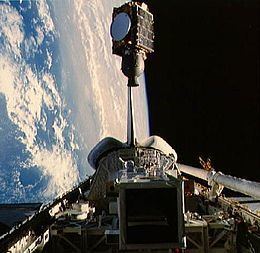Operator Arabsat Mission duration 7 years Launch mass 1,270 kg Bus Spacebus Mission type Communications satellite | COSPAR ID 1985-048C Launch site Kennedy LC-39A Period 24 hours Launch date 17 June 1985 | |
 | ||
Similar INSAT‑2DT, Kosmos 1667, Kosmos 1686, Spacebus, Brasilsat‑A1 | ||
Arabsat-1B was a Saudi Arabian communications satellite which was operated by Arabsat. It was used to provide communication services to the Arab States. It was constructed by Aérospatiale, based on the Spacebus 100 satellite bus, and carried two NATO E/F-band (IEEE S band) and twenty five NATO G/H-Band (IEEE C band) transponders. At launch, it had a mass of 1,270 kilograms (2,800 lb), and an expected operational lifespan of seven years.
History
Arabsat-1B was launched aboard Space Shuttle Discovery on mission STS-51-G. Discovery was launched from LC-39A at the Kennedy Space Center at 11:33:00 GMT on 17 June 1985. It was deployed from Discovery, and boosted to a geosynchronous transfer orbit by means of a PAM-D upper stage. Sultan bin Salman bin Abdulaziz Al Saud flew aboard the Shuttle to supervise deployment, becoming the first Saudi citizen and first member of royalty to fly in space. Morelos 1 and Telstar 3D were also deployed on the same mission.
Arabsat 1B was placed into a geosynchronous orbit at a longitude of 26° East. In October 1991, a problem developed with the spacecraft's altitude control system, causing it to drift eastward out of control. The same fault had developed aboard its sister satellite, Arabsat-1A, a month earlier. It failed completely in early 1992.
